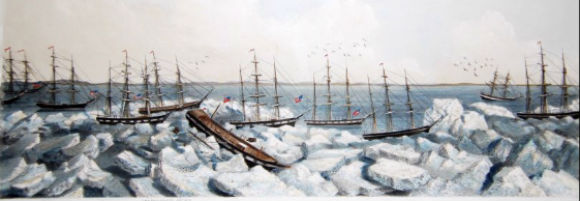 In 1871, a fleet of 33 American whaling ships became stuck in the ice off the coast of Alaska. Over 1,200 whalers were rescued by the seven ships which managed to avoid being trapped in the ice floes. Remarkably, all aboard the trapped ships survived the ordeal.
In 1871, a fleet of 33 American whaling ships became stuck in the ice off the coast of Alaska. Over 1,200 whalers were rescued by the seven ships which managed to avoid being trapped in the ice floes. Remarkably, all aboard the trapped ships survived the ordeal.
On Wednesday, the National Oceanic and Atmospheric Administration (NOAA) announced that they believe that they have located the wreckage of two of the lost whaling fleet on the bottom of the Chukchi Sea near the Inupiat village of Wainwright.
In addition to the crushed hulls of the ships, the NOAA archaeological team found anchors, fasteners and brick-lined furnaces that were used to render blubber. “It was remarkable to find the ship pieces and associated items so well-preserved,” said Brad Barr, the chief scientist for the expedition carried out by the Maritime Heritage Program in NOAA’s Office of National Marine Sanctuaries.
The loss of the ships in 1871 was a disaster to the whaling industry. The first oil well had been drilled in Pennsylvania in 1859 and petroleum was increasingly competing with whale oil. Whales were harder to find, leading whaling ship from New England to hunt for whales in the treacherous waters of the Bering Sea. The loss of the ships and gear was estimated to have been $1.6 million or roughly $32 million in today’s dollars.
Of the 33 ships trapped in the ice, one survived. In 1872, the bark Minerva was discovered intact and subsequently salvaged, but the rest were crushed in the ice, sank, or were stripped of wood by the local Inupiat.
Search for the Lost Whaling Fleets of the Western Arctic
Thanks to Irwin Bryan and Phil Leon for contributing to this post.

I never thought about this but I’m kind of surprised they would use furnaces on board to render blubber. I guess rendered blubber is less weight and space than a bunch of thick whale skins so it was probably done out of necessity but I wonder how safe it was to have a giant furnace on a wooden ship. I guess that’s where the brick lining comes in.
Really interesting read, I hadn’t heard about this.
The American ships which could be away in the Pacific for several years, needed to render the blubber into oil to preserve it. The Scottish whaling ships which had shorter trips, hunting whales off Greenland, cut up the whale blubber in blocks and stored it in barrels to be rendered into oil when they returned to port.